



Patrick Lichty, renowned conceptually-based artist, writer, curator and activist. He has exhibited internationally since 1990. Featured image: taken by Anne Helmond.
Introduction.
Patrick Lichty is an individual who seems to be like a non-stop engine. A hungry human being, engulfed in a prolific journey of constant exploration, whether it be making artworks, writing, activism, curating, collaborating, researching or teaching; he’s deeply involved and engaged in media arts culture. Since 1990, he has pursued art and writing that explores how we relate to one another through technology and how we relate to it. This includes art, media, and computer technology. “Media are one of the “glues” of civilization, and this glue is as fundamental in representing all aspects of society, culture, and interpersonal relations. I explore this through critical theory, conceptual New Media art, and performance/social intervention.”
Lichty also works in almost all forms of Digital 3D – Animation, VR, Fabrication, Physical Computing. Translating the work for display through video, animation, live installation, electronics, virtual reality, physical computing, robotics, digital fabrication and imaging. As well as realising virtual works into traditional forms such as plates for print, paintings, expanding the focus of his work in a broader context.
Lichty’s work, concepts and practice do not rest in one place, it crosses over into many areas of creative production. By getting his hands dirty with the medium of technology, with its relational aspects. The spirit of the work goes beyond singular catch phrases and one-liners, adding complexity and value which only media art and its ever widening scope can demonstrate.
It’s big art with big ideas, interwoven with micro levels of human emotion, asking questions about life and more. This two part interview aims to clarify some questions I have been wanting to ask Patrick Lichty for a while now, so hang on and lets see what happens…
Start of Interview:
Marc Garrett: You have been deeply engaged in the creation of net art, networked art, media art and related activities at various levels, whether it has involved you making it, writing about or curating it. What inspired you to choose which is, now unquestionably, one of the most contemporary and expansive forms of creativity, in the first place?
Patrick Lichty: This is a question that has come up repeatedly. “Why did you choose (what is now called) New Media, or the intersection between society, technology, and culture?” It is really a matter of examining my native culture, which has been that of technological culture. I was raised by an artist who gave me my first electronics set at the age of 8, and my first computer by the age of 17, while raising me on a steady diet of science fiction. I was a child of McLuhan; growing up in the electric networks on a diet of very hot media. However, I do also paint, and when I think it’s appropriate, I also do use traditional media. In short, I speak this culture because it’s my native language.
MG: To kick off this interview I thought it would serve our readers well to discuss your work from a perspective of themes. Over the years, exploration through your practice has crossed over into many different disciplines and fields. So lets begin with Psychogeography. To those who are unfamiliar with this practice, the most well defined and serious use of it was in 1955 by Guy Debord: “a whole toy box full of playful, inventive strategies for exploring cities … just about anything that takes pedestrians off their predictable paths and jolts them into a new awareness of the urban landscape.”
“Of all the affairs we participate in, with or without interest, the groping quest for a new way of life is the only thing that remains really exciting. Aesthetic and other disciplines have proved glaringly inadequate in this regard and merit the greatest indifference. We should therefore delineate some provisional terrains of observation, including the observation of certain processes of chance and predictability in the streets.” Introduction to a Critique of Urban Geography. Guy Debord
Patrick, one of your projects which springs to mind, is a work called SPRAWL “…an exploration of the suburban American landscape, examining the macrocosmic issues related to suburban expansion by considering the microcosmic issues of the experiences of a bellwether area of the US: Stark County, Ohio. In navigating the landscape you will view over thirty panoramic photographs of sites that are now forever changed by the area’s development as well as interviews on video and historical documents which create a map of the larger social landscape of the surrounding community.”
A complex and involved project. What inspired you to examine the ‘suburban American landscape’ in such a way, and how long did it take to complete?
PL: In talking about Debord’s definition, I’d like to talk about my own interpretation of the idea of Psychogeography. If you consider the word etymologically in contrast with Debord’s meaning, you can say that it should not be limited to the urban landscape, but the relationship of human interaction with any landscape. From this, we move out of the city to any relation between community and space, which is my interest, and I like to term as a practice of ‘land use interpretation’ to borrow Matt Coolidge’s (CLUI) term. All of my work in this range, from SPRAWL to the three projects in varying stages of completion (the Hulett Project, Ghosts of Adak, and SPRAWL 2011) come from a personal observation that expands to a macroscopic discourse through the larger exploration/research of the space.
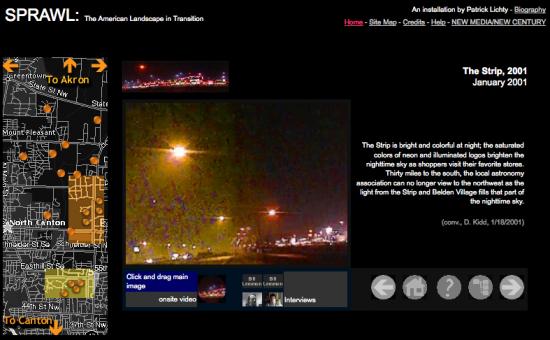
SPRAWL began as a 3-year personal investigation of my own distress about suburban sprawl in the late 1990’s near my home town, and linking this to the larger national conversation regarding sprawl at the time. For reference, I was born in nearby Akron, Ohio – the subject of Chrissie Hynde and The Pretenders song My City Was Gone, which describes the colonization of an industrial city and its countryside by sprawl and shopping malls, so if SPRAWL has a soundtrack, that would be it. I began SPRAWL in 1998, as a series of panoramic photographs of various sites near my home, with just a vague impression that they were a cohesive body of work. Also, the idea of nostalgia for the pastoral farmland of my younger days seemed far too simple to be satisfying, so I knew there was something to it. So, when the Smithsonian American Art Museum put out a call for works dealing with landscape online, I felt this was a fantastic place to really explore this idea in a larger context. Then they offered me the commission, the project went from a set of 32 panoramas to a hyperdocumentary in about three solid months of production, including travelling back to Ohio from Louisiana, interviewing, doing on-site footage, and performing historical research.
What I think is important about SPRAWL is that it’s ‘sensable research’, in that it managed to manifest the ideas I had about this problem, learning a lot more about community ecology, allowing the articulation of a microcosmic issue in macroscopic terms. In more personal terms, it allowed the development of my question of social issues related to my concern with the understanding that my perspective was only one of many, and from examining a multitude of perspectives, I could learn what the larger issues were, and create a discourse with a larger community.
MG: On your website, for the Ghosts of Adak there is a statement of yours, saying “My father and I have something in common. He was born in 1921 and spent 2-1/2 years in the North Pacific campaign on Adak Island in the Western Aleutian Islands in Alaska. I have heard about it since 1962. So I went there for 10 days. And I found him all over again.”
I also visited another site to find out about the community living there, and on this site called Alaska Tracks. Ned Rozell writes “Adak’s having a tough time, and the community of about 200 people in the mid-Aleutians has been struggling since the Navy pulled about 6,000 people out in 1997. It’s got a feel to it now like the Love Canal area of Niagra Falls had in the 1980’s, like everyone took off and left a few ghosts behind.”
How was your 10 days stay there and what did you learn?
Do you have a clear idea of what this project will become? Also, I noticed that it is part of an artist residency program at Eyebeam R&D Atelier NYC. How do you intend to present this work, in a space, on-line or something else?
PL: That’s a book in itself, and probably will be, which is part of your next question. First, why – My father is nearing 90, and for most of my life, he had gone on about this “place” that he had been for a period of time, and recounting endless stories about it. No place else had that sort of impact on him. Does not talk about Seattle, or San Francisco, or even Chicago (all places he had spent time) like that. I also think that as he is nearing 90, and in that he and I have a very strong bond (actually both Lodge brothers, if you can believe that), and I wanted to know about him in the deepest way possible, and probably in so doing, learn about myself and the site. But then, that fits the process.
The issue with Adak is that it is a tremendously complex place even before I overlay my own emotional architectonic. It was the site of the Northern Pacific campaign of the United States versus Japan during the Second World War, mainly as a diversion from Midway. I had made a deal with the CEO of the facility to exchange the photos for a room, a 40-something Niigata-born guy with petrochemical ties, whose father might have been my father’s enemy, and ideologically, probably was mine, but the personal nature of the trip put that on hold. There were a lot of external and internal conflicts that I had to navigate just to get there.
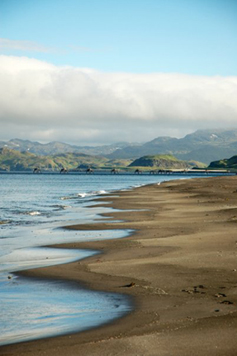
In short, Adak is currently the remains of the Adak Naval Base and surrounding facilities, which is basically a minor port, petrochemical storage facility, a fishery, and home of the westernmost airport linked to the Continental US, further west than Hawaii. If you rent a car, you rent one of the trucks a local offers, the gas comes from the tank farm, and the ‘hotel’ is a number of duplexes that the residents rent out to visitors. There is a General Store, a cafe at lunchtime, and the old VFW becomes the tavern for dinner, offering an entree or some microwaveable snacks along with a full bar. You sign a disclaimer to absolve the Corporation of any liability if you encounter black mold, fall into an old stairwell, sinkhole, run into an old unexploded shell, etc. I’m speaking a little darkly about this place, but it’s pretty rugged with radically changing weather, frequent earthquakes, and they’re still cleaning up the old artillery ranges.
On the other hand, it’s one of the most amazing places to be. It’s right at the edge of civilization, a volcanic arctic island withn no trees and some of the most amazing wildlife you’ve ever seen – eagles, otters, seals, birds. I can see why my father talked about it so much.
One other thing of note is that while doing the project, I’ve run into all sorts of people who have served, lived, or even been born there, as there was a 6,000-person family facility. On the plane from Minneapolis to Anchorage, I ran into an airline pilot who had just been on a caribou hunt there, and he gave me his GPS information and a lot of pictures. On another trip, I ran into a woman who was born there. It was unbelievable.
What did I learn? I learned about a history that few remember, I learned about my own history and how it affects me. I also learned about the local culture, its history, how Alaskan culture meshes with corporate interests to create a lot of the issues seen in mass media. There isn’t a lot of concern for the area from the locals, and actually the Military was doing a decent job with the cleanup. From a more personal level, I also came to understand that everything is transitory. Art, culture, society, all ephemeral in terms of a mountain. Human beings don’t matter very much to a volcano, but definitely the other way around.
When I was walking on the western (uninhabited) side of the island, I had napped on some tundra and realized I didn’t have my GPS or keys – all my keys. I knew where I slept, and I leave my keys in the car a lot. The worst that could happen was that I would have to walk 5 miles into town in a cold drizzle, get Jimbo the Constable to let me into my car and get the truck in the morning. In the end, I learned that if it isn’t a landmine, it’s not that big of a deal.
“Do you have a clear idea of what this project will become? Also, I noticed that it is part of an artist residency program at Eyebeam R&D Atelier NYC. How do you intend to present this work, in a space, on-line or something else?” This is really tough for me – no, I don’t have a clear idea yet because it’s so hard to frame. It probably needs to be a book, but it isn’t going to be done for a couple more years. I’d like it to be a hyperdocumentary like SPRAWL, but not in the same way. Also, I think it would make a great presentation, and the images are really beautiful. As I mention, it’s terribly hard to frame this project, and I think it should be allowed to be large.
MG: Let’s talk about a piece you created with The Yes Men. As many in the know, know – and of course those who have fallen foul to the Yes Men’s activist-pranks; they are legendary cultural saboteurs. They have impersonated World Trade Organization corporate spokespersons, including Dow Chemical Corporation, Bush administration spokesmen on TV, at various business conferences around the world. In order to demonstrate some of the mechanisms that keep bad people and ideas in power. Focusing attention on the dangers of economic policies that place the rights of capital before the needs of people and the environment. They have more recently become more known to a world-wide audience for The Yes Men, a movie.
Could you inform myself, and readers about the mock industrial video ReBurger and how it came about?
PL: Right. The animation work for The Yes Men is a strange beast, because it came from previous work for a group called RTMark, from which some of us came from to do Yes Men, which is well documented in the two movies. Again, the process for these animations, which I later edit into industrial videos is also an odd one. Usually, when there is an intervention (and I have sometimes appeared in person), Mike will give me a call and say something like, “Hey Patrick, we have this idea for this, for that company…” In this case, it was an idea for recycling feces for the Third World, and not much beyond that general concept. At first, I was thinking of translating dietary fiber to textile manufacture, creating a suit that would look like S**t, but shortly thereafter, brainstorming created the McDonald’s parody. I knew it was going to be shown at Plattburgh College, but beyond that, I didn’t have much context. So, that’s where my process in context with the larger presentation sort of diverges. Mike, Andy and Matt were developing the presentation, and I started in on the simple metaphor of eating shit. In short, I get some basic ideas together, and then produce the clips (not the full industrial video).
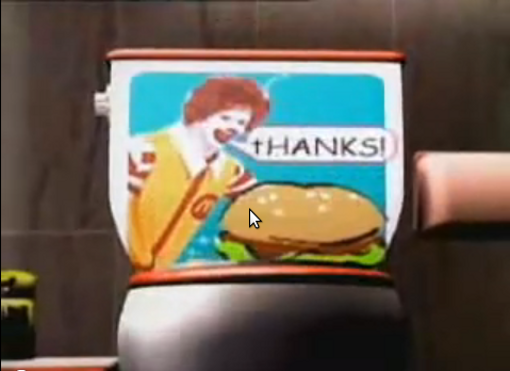
Beyond that basic joke, it’s really just exaggeration – the idea of an international infrastrucure for the collection of post-consumer waste, the branded toilet, and the special product names, like “McDung”. The scene that seems to get people is the one of the Ronald McDonald Colostomy Machine (the paste dispenser) as it creates the brown coil of reprocessed waste and then presses it into nice patties. For me, this is the use of pure literal metaphor, and maybe that’s why it works. Maybe it’s because it stands for a corporation that offers “choices” for healthy eating that few choose, and McDonalds willingly contributes to the obesity and illness of billions. In my opinion, ReBurger just tells the truth.
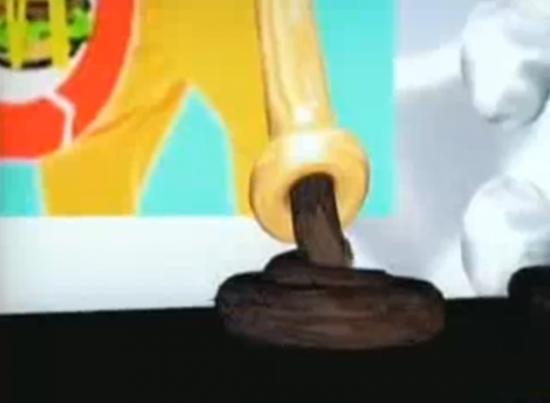
But the reason why people like the video is also a reason why it was a real problem for the sale of the movie at Sundance 2003. Although it was obvious fair use, many in the film industry were also buyers looking at the movie. Mike Bomnano told me that the legal departments of the movie companies were trying to determine the degree of risk of satiring McDonald’s, complete with branding. This was obviously Fair Use under US Copyright, but again, the possibility of an egregious law suit could have happened. In the end, McDonalds decided to ignore the piece, which was great, since I believe it’s one of the stronger Yes Men pieces.
MG: In the UK, June 1997, the infamous McLibel Trial (mcspotlight.org) came to an end. The case was between McDonald’s and a former postman and a gardener from London, Helen Steel and Dave Morris. It ran for two and a half years and became the longest ever English trial. “…Helen and Dave decided that they would stand up to the burger giants in court. They knew each other well from their involvement in community based campaigns in their local North London neighbourhood and felt that although the odds were stacked against them, people would rally round to ensure that McDonald’s wouldn’t succeed in silencing their critics.” The defendants were denied legal aid and their right to a jury, so the whole trial was heard by a single Judge, Mr Justice Bell.
“The verdict was devastating for McDonald’s. The judge ruled that they ‘exploit children’ with their advertising, produce ‘misleading’ advertising, are ‘culpably responsible’ for cruelty to animals, are ‘antipathetic’ to unionisation and pay their workers low wages. But Helen and Dave failed to prove all the points and so the Judge ruled that they HAD libelled McDonald’s and should pay 60,000 pounds damages. They refused and McDonald’s knew better than to pursue it.” Mcspotlight.
I can imagine that McDonald’s were considering their past experience, with cases such as the McLibel Trial. “The legal controversy continued. The McLibel 2 took the British Government to the European Court of Human Rights to defend the public’s right to criticise multinationals, claiming UK libel laws are oppressive and unfair that they were denied a fair trial. The court ruled in favour of Helen and Dave: the case had breached their rights to freedom of expression and a fair trial.”
For your project 8 Bits or Less, in 2002, you wrote a brief statement which I am assuming must be about your own condition, saying “An artist who has become blind (whether physically or ideologically) has resorted to viewing his world through the prosthetic devices that constitute his sense, like cell phones, and wristcams. The result is a distorted landscape that considers Situationist theory, surveillance culture, identity, and alien abduction.” Can I begin by asking why this statement came about and then what part of the project you feel communicates or is expressesed most successfully?
PL: First on the matter of ReBurger, I think that the smarter entities know not to react, but that isn’t always the case. Perhaps the ones who have been burned, now have a smarter PR team.

8 Bits or Less is a series I did that was influenced by several things. For many years, I had felt that as technological artists we are slaves to “innovation”, which is merely an exciting word to stand in for the commercial upgrade path in software and hardware. This set of videos addresses my dissatisfaction with the notion of verisimilitude in regard to techological art, or the “big ticket” piece. Ever since the late 1990’s my response has been to either get by with just enough aesthetic polish to make the work believable/legible, or to willingly embrace a low rez/grayscale time. The lo-fi grayscale is not the same as 8-Bit, which has 256 colors and refers to early personal computing and video games. Perhaps it is closer to my passion for Slow Scan television (a 1970’s video modem technology in which a frame is transmited every 7 seconds) or my position of eschewing resolution and color depth as a form of intransigent aesthetics. In addition, the fact that the frame rate is at most 3 frames per second, and was shot with a Casio Wristcam at one frame every 1.5 seconds was also my homage to Muybridge, mainly in terms of the grayscale and serial qualities of the video. Beyond that, and the fact that each video consists of about 900 frames, all hand edited, perhaps 8 Bits or less is more about my politics about the technological industry and personal differences with New Media and technolust.
On the personal side, 8 Bits or Less is an allusive fable having to do with the fact that I have been blind a couple times in my life, but this blindness can translate to the fact that for a period of time I felt that I had immersed myself in my studio for long enough, that I saw the world primarily from my screen. Therefore, although I had been visually imparied for part of my life, much of which has been fixed by having cataract removal in 1999, I still felt that there was a metaphorical blindness caused by society’s use of mobile devices, the existential distorions of 24-hour cable networks and the Internet. Therefore, the series (if you listen very closely) incorporates a mix of postmodern theory and hyperbolic statements about aliens, obscure jokes about bits and nybbles, surveillance culture and the abjection of low fidelity.
What I think is successful about it is that it holds together at all, or that it engages the viewer without necessarily relying on leading edge technological conceits, but perhaps using the wristcam aethetic is a conceit in itself. Antoher aspect that I have enjoyed about it after five or six years is that it is a really hallucinogenic series of pieces. But then, I think this is the point that Gibson made about cyberspace that has been expanded on by the Baudrillardian mediascape and the Internet – the consensual mass hallucination (facilitated by mass communications).
———
Watch 8 Bits or Less series. Images link to videos online.
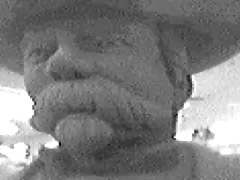
A wristful of bits. Found on DVlog.
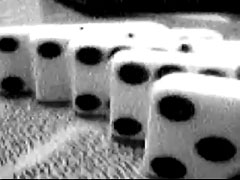
8 bits or less. Found on DVlog.
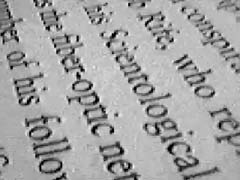
http://www.dvblog.org/movies/04_2007/lichty8bit/closevision.mov
Close vision. Found on DVlog.
Big thanks to DVblog for 8 Bits or Less images & video links.
http://dvblog.org/